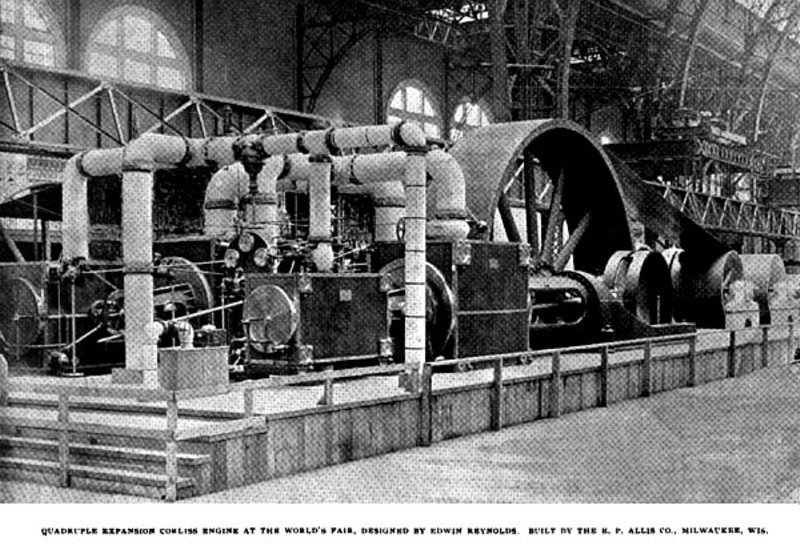|
Title: |
1893 Article-E. P. Allis & Co., Quadruple Expansion Corliss Steam Engine |
|
Source: |
Cassier's Magazine May 1893, pg. 34 |
|
Insert Date: |
11/13/2012 1:08:35 PM |
That with such extensive provisions for the exhibit of machinery the latter will form a most important feature of the Exposition seems almost needless to say, and that steam engines will be of the first prominence in this line of exhibits will be equally well appreciated. Interest will undoubtedly be centred in the large Corliss engine, one of magnificent proportions, built by the E. P. Allis Company, of Milwaukee, Wis., and suggestive at once of comparison with the famed Corliss engine used in Machinery Hall at the Philadelphia Centennial Exhibition in 1876, which was built by George H. Corliss.
The illustration of that engine, shown on another page, will give the reader some idea of the great dissimilarity of the two. This Corliss engine, at the time one of the finest examples of its type ever constructed, had a pair of forty-inch cylinders, of ten foot stroke, and while its full power was never developed, it supplied something like 1250 horse-power while in operation at the Exhibition. The length of the beams, between centres, was twenty-five feet, the diameter of the crank-shaft was nineteen inches, and the diameter of the fly-wheel was nearly thirty feet. The revolutions of the Centennial engine per minute amounted to thirty-six, and it may be of interest to know that the total number of revolutions made during the exhibition was 2,355,300.
The duty of the World's Fair engine will, however, be of a different nature from that of the Corliss engine at the Centennial, which transmitted its power to the main jack shaft. The Allis engine is belted by two belts made by the Page Belting Company, of Concord, N. H., to two Westinghouse dynamos, each of a capacity of 10,000 incandescent light. The speed necessary for these machines to produce 20,000 light of sixteen candle-power is 200 revolutions. The illustration shows only one belt, but when completed the second belt will be directly over the f1rst connected to the second dynamo immediately beyond. The fly-wheel is thirty feet in diameter, and at sixty revolutions, will have a periphery speed of over 5500 feet per minute. The face of the wheel is seventy-six inches, not as large as many others the Allis Company have built, but in construction it is probably stronger than any of its size ever made. It has twelve arms and the rim is made up of the same number of segments. It weighs complete 135,900 pounds, the rim itself weighing 88,000 pounds.
The engine is of quadruple-expansion arranged in the form of a pair of tandem compounds, with cylinders twenty-six, forty, sixty and seventy inches in diameter by seventy-two inch stroke. It will be observed from the accompanying illustration that a belt wheel is used instead of a rope wheel, a belt wheel having been considered more distinctively representative of American practice, and the belt also, a more durable device for power transmission. To many foreign visitors, the two belts will be a source of surprise, for most large powers abroad are transmitted by ropes. In Machinery Hall but one engine transmits its power in that way, and that is of English manufacture. This seems that notwithstanding the many advantages claimed for rope, American engineers do not think anything superior to leather belts. |
|
 1893 E. P. Allis & Co., Quadruple Expansion Corliss Steam Engine
1893 E. P. Allis & Co., Quadruple Expansion Corliss Steam Engine
|
|